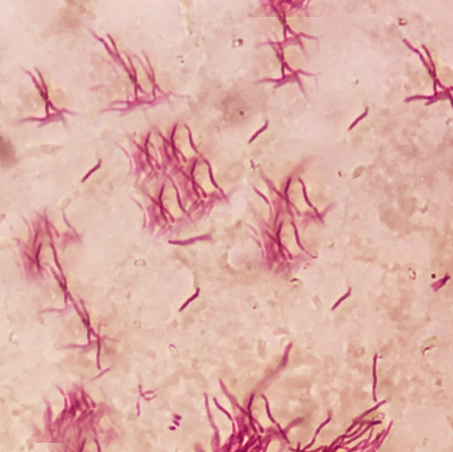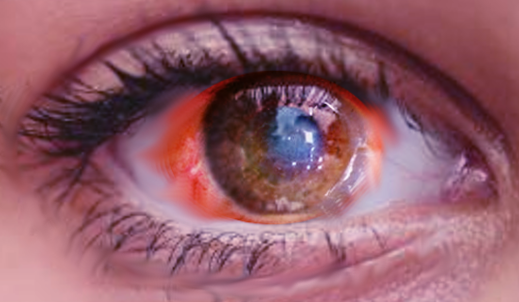[2]
Sridhar MS,Gopinathan U,Garg P,Sharma S,Rao GN, Ocular nocardia infections with special emphasis on the cornea. Survey of ophthalmology. 2001 Mar-Apr;
[PubMed PMID: 11274691]
Level 3 (low-level) evidence
[3]
Yin X,Liang S,Sun X,Luo S,Wang Z,Li R, Ocular nocardiosis: HSP65 gene sequencing for species identification of Nocardia spp. American journal of ophthalmology. 2007 Oct;
[PubMed PMID: 17698022]
[4]
DeCroos FC,Garg P,Reddy AK,Sharma A,Krishnaiah S,Mungale M,Mruthyunjaya P, Optimizing diagnosis and management of nocardia keratitis, scleritis, and endophthalmitis: 11-year microbial and clinical overview. Ophthalmology. 2011 Jun;
[PubMed PMID: 21276615]
Level 3 (low-level) evidence
[5]
Sridhar MS,Sharma S,Reddy MK,Mruthyunjay P,Rao GN, Clinicomicrobiological review of Nocardia keratitis. Cornea. 1998 Jan;
[PubMed PMID: 9436875]
[6]
Pérez-Santonja JJ,Sakla HF,Abad JL,Zorraquino A,Esteban J,Alió JL, Nocardial keratitis after laser in situ keratomileusis. Journal of refractive surgery (Thorofare, N.J. : 1995). 1997 May-Jun;
[PubMed PMID: 9183766]
[7]
Faramarzi A,Feizi S,Javadi MA,Rezaei Kanavi M,Yazdizadeh F,Moein HR, Bilateral nocardia keratitis after photorefractive keratectomy. Journal of ophthalmic
[PubMed PMID: 23275825]
[8]
Parsons MR,Holland EJ,Agapitos PJ, Nocardia asteroides keratitis associated with extended-wear soft contact lenses. Canadian journal of ophthalmology. Journal canadien d'ophtalmologie. 1989 Apr;
[PubMed PMID: 2659153]
[9]
Goel S,Kanta S, Prevalence of Nocardia species in the soil of Patiala area. Indian journal of pathology
[PubMed PMID: 8354557]
[10]
Trichet E,Cohen-Bacrie S,Conrath J,Drancourt M,Hoffart L, Nocardia transvalensis keratitis: an emerging pathology among travelers returning from Asia. BMC infectious diseases. 2011 Oct 31;
[PubMed PMID: 22040176]
[13]
Garg P, Fungal, Mycobacterial, and Nocardia infections and the eye: an update. Eye (London, England). 2012 Feb;
[PubMed PMID: 22173077]
[14]
Silva CL,Tincani I,Brandão Filho SL,Faccioli LH, Mouse cachexia induced by trehalose dimycolate from Nocardia asteroides. Journal of general microbiology. 1988 Jun;
[PubMed PMID: 3065451]
[16]
Beaman BL,Black CM,Doughty F,Beaman L, Role of superoxide dismutase and catalase as determinants of pathogenicity of Nocardia asteroides: importance in resistance to microbicidal activities of human polymorphonuclear neutrophils. Infection and immunity. 1985 Jan;
[PubMed PMID: 3880721]
[17]
Johansson B,Fagerholm P,Petranyi G,Claesson Armitage M,Lagali N, Diagnostic and therapeutic challenges in a case of amikacin-resistant Nocardia keratitis. Acta ophthalmologica. 2017 Feb;
[PubMed PMID: 27572657]
Level 3 (low-level) evidence
[18]
Brown JM,Pham KN,McNeil MM,Lasker BA, Rapid identification of Nocardia farcinica clinical isolates by a PCR assay targeting a 314-base-pair species-specific DNA fragment. Journal of clinical microbiology. 2004 Aug;
[PubMed PMID: 15297512]
[19]
Patel JB,Wallace RJ Jr,Brown-Elliott BA,Taylor T,Imperatrice C,Leonard DG,Wilson RW,Mann L,Jost KC,Nachamkin I, Sequence-based identification of aerobic actinomycetes. Journal of clinical microbiology. 2004 Jun;
[PubMed PMID: 15184431]
[20]
Galor A,Hall GS,Procop GW,Tuohy M,Millstein ME,Jeng BH, Rapid species determination of Nocardia keratitis using pyrosequencing technology. American journal of ophthalmology. 2007 Jan;
[PubMed PMID: 17188068]
[21]
Reddy AK,Garg P,Kaur I, Speciation and susceptibility of Nocardia isolated from ocular infections. Clinical microbiology and infection : the official publication of the European Society of Clinical Microbiology and Infectious Diseases. 2010 Aug;
[PubMed PMID: 19832708]
[22]
Patel R,Sise A,Al-Mohtaseb Z,Garcia N,Aziz H,Amescua G,Pantanelli SM, Nocardia asteroides Keratitis Resistant to Amikacin. Cornea. 2015 Dec;
[PubMed PMID: 26418432]
[23]
Cunha LPD,Juncal V,Carvalhaes CG,Leão SC,Chimara E,Freitas D, Nocardial scleritis: A case report and a suggested algorithm for disease management based on a literature review. American journal of ophthalmology case reports. 2018 Jun;
[PubMed PMID: 29780901]
Level 3 (low-level) evidence
[24]
Tseng SH,Chen JJ,Hu FR, Nocardia brasiliensis keratitis successfully treated with therapeutic lamellar keratectomy. Cornea. 1996 Mar;
[PubMed PMID: 8925664]
[25]
Shah P,Zhu D,Culbertson WW, Therapeutic Femtosecond Laser-Assisted Lamellar Keratectomy for Multidrug-Resistant Nocardia Keratitis. Cornea. 2017 Nov;
[PubMed PMID: 28834821]
[26]
Lalitha P,Tiwari M,Prajna NV,Gilpin C,Prakash K,Srinivasan M, Nocardia keratitis: species, drug sensitivities, and clinical correlation. Cornea. 2007 Apr;
[PubMed PMID: 17413948]
[27]
Srinivasan M,Sharma S, Nocardia asteroides as a cause of corneal ulcer. Case report. Archives of ophthalmology (Chicago, Ill. : 1960). 1987 Apr;
[PubMed PMID: 3551895]
Level 3 (low-level) evidence
[29]
Broadway DC,Kerr-Muir MG,Eykyn SJ,Pambakian H, Mycobacterium chelonei keratitis: a case report and review of previously reported cases. Eye (London, England). 1994;
[PubMed PMID: 8013708]
Level 3 (low-level) evidence


